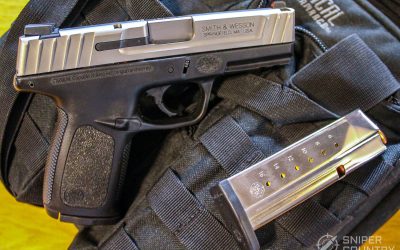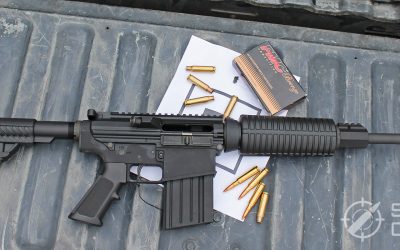Smith and Wesson 617 summary
- Non-exist recoil makes it the perfect trainer for novices and professionals alike.
- Smooth and dependable – the mechanics of this gun work effortlessly.
- Affordable ammo – .22LR is relatively cheap and increasingly popular.
- Smith and Wesson Lifetime Warranty – enough said.
- MSRP of $853 – expensive for most but an investment that holds value.
Introduction

A descendent of the 1899 K-frame
Smith & Wesson’s Model 617 shares the company’s K frame heritage that stretches back to 1899. K frame guns were worn by American soldiers in both World Wars, served as duty weapons to virtually every police agency in the country, and provided millions of citizens with one of the industry’s most reliable and stalwart revolvers.

If we decode Smith & Wesson’s rather cryptic numeric nomenclature, we get some clues about the 617. The “6” denotes a stainless steel frame. And the “Model 17” was — prior to the numbering system — known as the “K-22.” As this somewhat less cryptic name suggests, this gun is a full frame revolver chambered in the venerable .22 long rifle cartridge.
Let’s pause and consider why this is important. Since the 617 is a full-sized revolver, it could be used as a rimfire training aid for someone carrying a K frame revolver as a duty weapon. Given the heft of the 617, it could make an ideal first gun for a new shooter being welcomed into the sport. And the gun’s 10 round cylinder could make it an ideal revolver for competition.

BONUS OFFER: Get your free shooting range targets to print at home!
Get your free targets to print at home!
Stainless Steel Cache
Stainless steel revolvers have the extra caché of a more durable finish. The price is commensurate with this, and the MSRP of $853 (for either the 4″ or 6″ model) will turn off some buyers. If we think about the 617 as an investment in one’s shooting, though, it quickly becomes apparent that this particular investment will pay a lot of dividends.
Non-existent recoil
Many years ago, yours truly was introduced to handgun shooting at a range that loved to rent the 617 to first time shooters. The gun felt great in my hands, and the non-existent recoil hooked me. Twenty years later I decided to add this gun to my arsenal, and it’s become a favorite of mine at the range. It has also been the single best tool I’ve found to learn to manage a double action revolver trigger.
Smith and Wesson 617 hands on
The Model 617 is not a light gun. The shorter 4″ version weighs in at a stout 39 ounces, and the 6″ barrel variant adds another 5 ounces, bringing it just shy of 3 pounds. You feel this when you pick up the gun by its beefy rubber grip, which gives all four fingers plenty of meat to hang on with.
The 617’s target sights are typical of Smith & Wesson’s revolvers: well-placed, clearly visible, and easily adjusted. The front sight is pinned into the barrel and the rear sight is held in place with several screws. Both could be easily replaced, but I’m not sure why you’d want to; this is a time-proven design that has served legions of competitive shooters well.

As is the case with any target K frame gun, the hammer has a wide knurled perch for the thumb, and the trigger is properly contoured for a clean pull.
The cylinder is recessed as many K frames of yore were, and the extractor lives in a full-length shroud that gives the Model 617 a clean and modern look. Wheel guns generally evoke warm feelings of heritage, but the Model 617 holds its own against the latest polymer guns with its timeless brushed steel finish.
Smith and Wesson 617 specs
| Model | Model 617 |
|---|---|
| Caliber | 22 LR |
| Capacity | 10 |
| Length | 9.13 |
| Front Sight | Patridge |
| Rear Sight | Adjustable |
| Action | Single/Double Action |
| Grip | Synthetic |
| Cylinder | Material Stainless Steel |
| Barrel | Material Stainless Steel |
| Frame Material | Stainless Steel |
| Frame Finish | Satin Stainless |
| Barrel Length | 4" (10.2 cm) |
| Weight | 39.0 oz. |
Shooting the Smith and Wesson 617
No mechanical fuss, an absolute pleasure
Cocking the hammer on a Model 617 and pulling the trigger reveals one of the shooting sports’ great joys. With no muss or mechanical fuss, the 617 launches projectiles with an anticlimactic whiff of recoil. In fact, I sometimes pause after shooting my 617 in single action and wonder why everyone on the firing line doesn’t have a 617 in their hands.

Smooth single and double action
Like all great guns, there’s a lot more to the 617 than shooting it in single action. Smith & Wesson’s K frame triggers are well known for their smooth double actions, and the 617 doesn’t disappoint here. The hammer gracefully arcs back and releases crisply. I’ll note here that a lot of revolver shooters don’t practice shooting double action nearly as much as they should, and the 617 is the perfect remedy for this. It doesn’t take long to acclimate to the negligible recoil. This does a lot to assuage trigger jerkiness and anticipatory flinching. With a gun this easy to shoot, it doesn’t take long to develop the muscle mechanics necessary for a textbook-perfect double action pull.
For happy shooting, a speedloader is a must
Oddly, one of the only frustrations with the Model 617 is the time needed to load it. For this, I highly recommend some speedloaders. These greatly simplify (and speed up) loading ten little pills into the 617’s chambers. I use The Revolver Supply Company’s speed loaders and loading block.
The Model 617’s heft doesn’t completely eliminate the recoil, but it greatly diminishes it. With subsonic loads the 617 is noticeably quieter than most other guns — something that your neighbors at the range will appreciate.

Popular Articles
Smith and Wesson 617 maintenance
A bore snake is recommended
To keep my 617 in top operating condition, I generally use a bore snake to clean the barrel and cylinder bores. Some patches I soak in gun cleaner to remove the soot and oils that build up on and around the cylinder.
Check out our guide on the best cleaning kit if you’re, like me, very careful with my guns.
Despite temptation, do not clean the staining on the front of the cylinder
Some shooters are particularly compulsive about removing the staining that inevitably develops on the front of the cylinder, and will sometimes use abrasive products to do this. There’s a good reason to not do this: the clearance between the front of the cylinder and the barrel is carefully set at the factory, and abrading the face of the cylinder will upset this. For all of my stainless steel guns, I use a small bit of copper wool to remove the most stubborn soot. Copper wool wrapped around a bronze cleaning brush also works great for removing stubborn lead deposits.

Avoid tearing apart your gun without assistance
The double action trigger mechanism of any revolver isn’t something that people should lightly tear into. It’s a symphony of little springs, levers and pins that can easily overwhelm the uninitiated. Without the proper tools and training, I don’t recommend doing this.
Take advantage of Smith and Wesson’s lifetime warranty
New Smith & Wesson Model 617’s enjoy a lifetime warranty. In the unlikely event that the gun needs repairing, a call to Smith & Wesson’s excellent customer service will get the gun back to the service department for a quality repair.

Who competes with the Smith and Wesson 617?
Double actions: the Ruger GP100 and Taurus Tracker 922
There are several high quality .22 caliber double action revolvers on the market that the Model 617 competes with — Ruger’s excellent GP100 revolvers and Taurus’s Tracker 992. Like the Model 617, these guns all share platforms with their larger bored siblings. The Ruger holds 8 rounds and the Taurus holds 9, so neither has quite the capacity of the Model 617. However, that’s not going to be what sways most buyers one way or the other. The Model 617’s MSRP of $853 makes it the “premium” gun here; the Ruger slides in just under the Smith at $829, and the Taurus is somewhat cheaper at $706.

The Model 617 enjoys over 120 years of manufacturing prowess
Each gun has its own loyal following, and each does largely the same job at the Model 617. The Model 617 enjoys the 120+ year long pedigree of Smith & Wesson’s K frame. Frankly, a lot of buyers will be attracted to the Smith’s longevity and durability.
Single Actions: Ruger Single Ten, Taurus TX22 and Glock 44
Broadening the field a bit brings three other types of .22 caliber handguns into the fray. These include single action revolvers (like Ruger’s superb Single Ten), semiautomatic pistols (like the Taurus TX22 (our in-depth review can be found here) and the Glock 44). Additionally, target pistols (like Smith & Wesson’s SW22 Victory and the Ruger Mark IV). These are all excellent guns, but none of them have the simplicity, versatility and ubiquity that the Model 617 enjoys.

BONUS OFFER: Get your free shooting range targets to print at home!
Get your free targets to print at home!
My Verdict
Get it while rimfire ammo is cheap
It’s easy to overlook the S&W Model 617 at your local gun store’s counter, but it’s worth pausing and giving it a second glance. At a time when centerfire pistol ammunition is reaching a dollar a round, the relative affordability of .22 LR is enjoying a renaissance in popularity among a variety of shooters.

Maintains its market value
Smith & Wesson revolvers have always been a good investment. The savvy buyer won’t regret investing in a revolver that will hold its value in just about any market condition. The Model 617 is capable of delivering the goods at the range — challenging the novice shooter to develop good trigger discipline. It gives the experienced shooter a platform on which to master their double action technique.
Excellent holster options
The K frame architecture means that there are plenty of holster options — most of which could be shared with other K frame revolvers.
Did I mention Smith and Wesson’s lifetime warranty?
And should your 617 find itself in need of repair, Smith & Wesson’s lifetime warranty and excellent service department will get the gun back in the game.










![9mm Glock Models [Ultimate Guide]](https://snipercountry.com/wp-content/uploads/2018/10/Glock-17-vs-Glock-19-vs-Glock-26-vs-Glock-41-vs-Glock-43-WM-400x250.jpg)
![Handgun Caliber Chart [2025 Ultimate Guide]](https://snipercountry.com/wp-content/uploads/2018/10/Handgun-Caliber-Comparison-400x250.jpg)
![Rifle Calibers [Ultimate Guide]](https://snipercountry.com/wp-content/uploads/2018/12/Header-1900-400x250.jpg)





